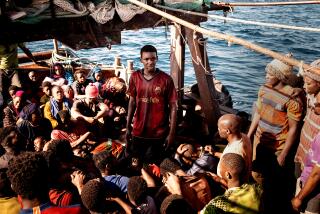The Exotic Is Easygoing in Memorable Senegal
- Share via
DAKAR, Senegal — I had a week to call my own, and a taste for something exotic. So I decided to go to Africa. But when I told friends my plan, they weren’t convinced that a week was time enough to visit such a faraway, unfamiliar place. They were convinced, however, that the jet lag would last me a lifetime. I reminded myself these friends had never been to Africa.
From New York to Dakar, Senegal, on Africa’s northwest coast, is a seven-hour flight--just a bit more than to Paris. And after a week’s time I find I have memories enough to give me a strong impression of this country.
It’s beginners luck to some extent. Senegal turned out to be an easy introduction to what seems to me a vast and mysterious continent. Easy, in part, because French is the official language, and has been since the French colonized Senegal in the 19th Century. (Wolof, an African tribal language also spoken by most residents of Dakar, is now vying for “official” status.)
Climate and Cuisine
The climate is not so unlike that of Los Angeles. Daily temperatures, even in July, average around 90 in Dakar and reach just over 100 in the rural south. Of course it is more humid, but everywhere in Senegal the nights are cooler.
There are enough “safe” foods for visitors. Because the country’s western border is the Atlantic Ocean, fresh fish is a staple, along with chicken, rice and mangoes. Foreigners are advised against drinking local water. But in Dakar even the natives carry a liter of bottled French water home with them after work, along with a baguette.
Dakar is not a beautiful city, despite the international flavor brought out by its active port. Storefronts are windowless single-story stucco buildings. During business hours their entire facades roll away and they resemble garages. The commercial district’s skyscrapers, seldom taller than 15 or 20 stories, have no more appeal than the drab corporate designs in U.S. cities.
Baby on the Back
But Dakar, like all of Senegal, is exotic by Western standards. Most women and men wear caftans or ankle-length dresses called bou-bous. Women “wear” their infants as well. With the baby on their back, they wrap their torsos in printed fabric that complements their outfit. Children are prized and protected in Senegal.
I had expected to bring yards of local fabric home with me, along with African jewelry. But I’m now convinced that Dakar is not for shoppers. The fabrics at couturier stores where women have their bou-bous custom made are expensive. And the jewelry is expensive ivory or a lacy filigree style, not the bold brass or silver type I expected. Most Dakar women prefer to wear Western jewelry.
Among the city’s best surprises is its quiet tone. The most aggressive sounds are the grumbling of old subcompact taxicabs, and the 5 a.m. call to Allah.
Early Evenings
There aren’t any streetlights to speak of and the sun sets well before 7 p.m. But the Senegalese are night owls who walk the dark streets or sit out in small social groups until almost midnight. Perhaps because of their Islamic roots or their ingrained sense of decorum, Dakar’s people are not demonstrative in public. Lovers show no signs of affection in the streets, mothers seldom discipline children--even the babies rarely cry.
For a day trip, my travel companion and I took the ferry to Goree, a small island off Dakar that once housed Africans waiting to be shipped into slavery in Europe and America as well as Mauritania, the African country that borders Senegal to the east.
It is a hauntingly beautiful place whose French Colonial stucco houses and government buildings recall New Orleans’ French Quarter.
For a taste of country life we traveled south by car to the Casamance region. It is the African alternative to a trip from Paris to Provence. With a driver born and raised in the Casamance region we rode for seven hours, through larger towns such as Kaolack and through the country’s savannah lands, to Ziguinchor. We went by way of Gambia, the tiny country colonized by the British that cuts into central Senegal.
Walkers Everywhere
To avoid the midday heat we left Dakar at 5 a.m. and took the one good road that winds through the countryside and skirts the local villages. Before daylight, people began to rise up from the dusty light. Villagers walk for miles along the side of the roads, going to draw water, catch fish, work in the fields or visit neighbors. Seeing them walking reminded me of Dakar, where residents also walk along the city streets rather than use the sidewalks.
Because there is no bridge, we took a ferry across the Casamance River that cuts through Gambia. It is an old and overworked boat, smaller than the Staten Island ferry, and we waited 5 1/2 hours to board it. A herd of goats went across before us but we left dozens of enormous produce trucks and about a dozen head of cattle behind.
Thanks to our driver’s close ties with family and friends in Casamance, we were able slip in and out of the local villages without creating concern. We saw women grinding maize and selling chilis from their gardens, men repairing farm tools and hauling firewood in cattle-drawn carts. People spoke African tribal languages, not French.
For all that was new and fascinating about the country, it was nice to spend our nights in more familiar surroundings. We found hotels with showers, indoor plumbing and air conditioners without any problem. In Casamance, we spent the night in Ziguinchor at the Hotel de Ville along with African businessmen and French and Italian tourists. Our room could sleep five. With breakfast for two, we paid about $6. In Dakar we stayed at the Hotel de la Paix. With breakfast the price for two was about $26 a night.
With a case of jet lag no worse than the one I’d take home with me from Paris, I can add one thing to my list of Africa impressions: A brief vacation in Senegal is surprisingly easy to take.
More to Read
Sign up for The Wild
We’ll help you find the best places to hike, bike and run, as well as the perfect silent spots for meditation and yoga.
You may occasionally receive promotional content from the Los Angeles Times.






